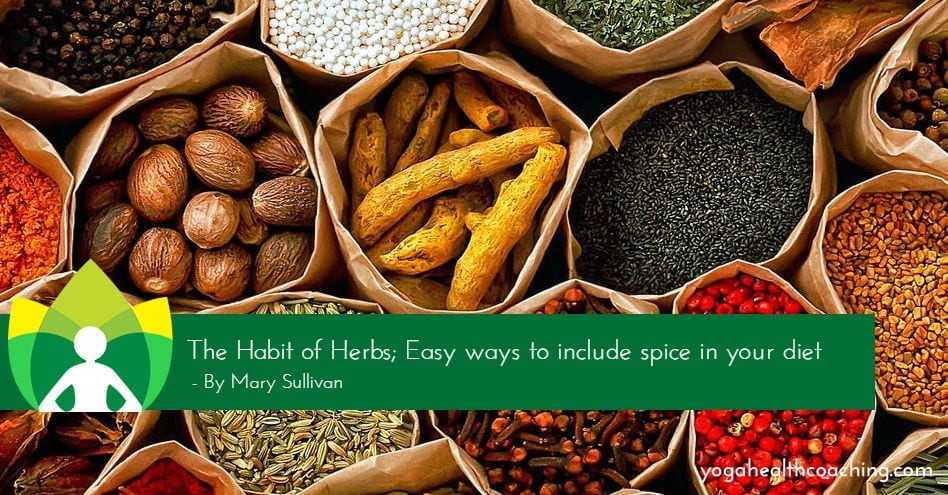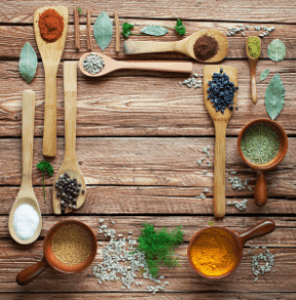
The Habit of Herbs; Easy ways to include spice in your diet
I love herbs and spice. It’s September and my herb garden is full, lush, beautiful and ready for picking. It’s my habit now to augment and enliven my food and drink with herbs and spice. Do you have the habit of herbs?
I grew up in a house with no herbs or spice, except ketchup and salt. I laugh when I think about those days now! I had to get to know herbs and spice as an adult. Now I add them to everything even my tea and drinking water.
As I started to study Ayurveda and the 6 tastes, kitchen spice fit right into the picture. Cate was one of my original mentors that peeked my interest through her video on the six tastes. I have since studied herbalism and brought spice and the 6 tastes into my cooking. Now I grow fresh herbs in my garden and my cabinet is full of dried herbs that I use regularly.
Kitchen Herbs, Spices and the 6 Tastes
 Sweet, Salty, Sour, Bitter, Pungent, Astringent are the 6 tastes that Ayurveda says help balance digestion. In most American homes our diet is heavy on the sweet, sour and salty. Herbs help balance any plate by adding one or two of the less common tastes. Add the bitter, pungent and astringent flavors to your plate boost digestion.
Sweet, Salty, Sour, Bitter, Pungent, Astringent are the 6 tastes that Ayurveda says help balance digestion. In most American homes our diet is heavy on the sweet, sour and salty. Herbs help balance any plate by adding one or two of the less common tastes. Add the bitter, pungent and astringent flavors to your plate boost digestion.
Herbs support good digestion generally. Ginger and Mint taste great in water and help you feel your best. John Douillard is another great resource for herbs used in Ayurveda to support digestion.
How are you going to make herbs and spice a regular in your diet? Scroll down below and share your thoughts recipes and ideas. Here are a few options to help you and clients spice things up.
6 Ideas to Jumpstart the Habit of Herbs in Your Home
- Look at the dishes with herbs you grew up loving. Dill pickles, Caprese salad, Garlic Bread, Salsa… Try the dill, basil garlic or cilantro in other ways to see if you enjoy them.
- Substitute a new herb in a standard recipe. I tried this with Pesto, I added Arugula instead of basil for a delicious peppery green sauce.
- Make sure your dried herbs are fresh. Many of us have herbs that have been in the cabinet for a decade. They have aged out of usefulness. Clear out anything that is older than a year or has dust on the bottle.
- Play a little. Mix a few dried kitchen herbs in a small bowl. Look them up on Herbal Living to discover their healing benefits. This is a fun project to do with your kid before dinner. Place the bowl on the dinner table in lieu of salt and pepper and ketchup. If your kids help you make it they will try it.
- Buy or grow fresh herbs. Teach your kids to water and pick living plants. A couple of pots on the porch or the counter are all you need. Even if you don’t have kids these make vibrant, colourful patio planters that you can enjoy with all your senses.
- Add herbs to your drinking water for fun and flavor. Clip some mint or slice ginger for a refreshing pick me up.
Plant the Seeds of Herbal Knowledge
 Add a new herb or plant into your garden each year and rotate out ones that don’t do well. I do and it keeps me learning and my food interesting. Pretty soon you will be growing and drying herbs to use all year long. In the summer and fall I make mixes with what is in full growth in my garden. In the winter and spring I use what I have dried or purchased.
Add a new herb or plant into your garden each year and rotate out ones that don’t do well. I do and it keeps me learning and my food interesting. Pretty soon you will be growing and drying herbs to use all year long. In the summer and fall I make mixes with what is in full growth in my garden. In the winter and spring I use what I have dried or purchased.
Using dried herbs in mixes is a wonderful way to get your family to give new herbs a try. Dried or fresh start simply with one or two you know you like and add on from there.
Connect with the Seasons
Seasonal spice mixes connect us to nature and it’s cycles. Ayurveda teaches us that specific herbs help balance the effects of Vata, Pitta and Kapha season. Many Ayurvedic cookbooks have seasonally based churna or spice mix suggestions for you to play with.
Here are a few of my favourite cookbooks to try:
- The Essential Ayurvedic Cookbook by Lois A. Leonhardi
- The Everyday Ayurvedic Cookbook by Kate O’Donnell and Cara Brostrom
- Eat Taste Heal by Thomas Yarema MD, Daniel Rhoda DAS and Chef Johnny Brannigan
Kitchen Herbs In Your Water
 One of the easiest, simplest ways to add herbs to your diet is in tea and water. After a full day in the garden I often feel a little wilted and need a boost. Basil, and lemon sorrel are two of my favorite yummy adds to my water.
One of the easiest, simplest ways to add herbs to your diet is in tea and water. After a full day in the garden I often feel a little wilted and need a boost. Basil, and lemon sorrel are two of my favorite yummy adds to my water.
Here’s a recipe from Rosemary Gladstar a healing herbalist, that’s great for a cool evening. Her book Medicinal Herbs: A Beginner’s Guide: 33 Healing Herbs to Know, Grow, and Use is a great resource for using herbs for cooking and healing.
½ cup honey
1–2 tablespoons cinnamon powder
To make the honey: Gently warm the honey until it is stirrable, and then stir in the cinnamon.
To use: Stir a teaspoon of the honey into warm water or herb tea. Or spread it over buttered toast. Or just lick it off a spoon; it’s that delicious!”
This cool refreshing drink works wonders on a warm day, I make it all summer long.
Mint Lemon Ginger Water
Ingredients Equipment
- 6 Fresh Mint Leaves ½ gallon Glass Pitcher or Mason Jar (Glass for flavor)
- ½ Lemon Cutting Board
- 2” of ginger Knife
- 2 quarts of water.
Instructions
- Wash Lemon, mint, and ginger
- Crush mint and add to water
- Slice Lemon and Ginger
- Add to water.
- Allow to steep for 6 hours.
This works great in sparkling mineral water as well. Sip and keep hydrated!
Click this link for some more ideas to brighten up your water and add the 6 tastes to your day.
Do you have a favorite combination for water? Scroll down and share it with our community. Enjoy!


